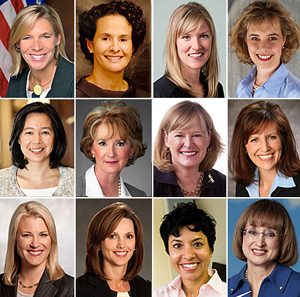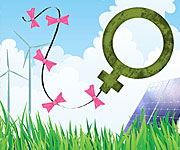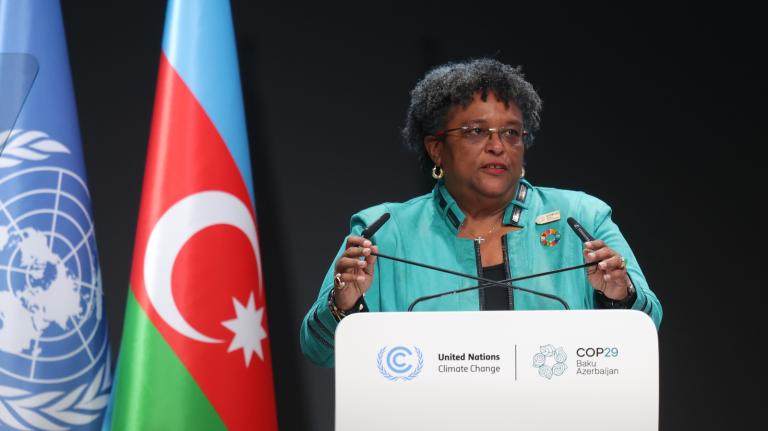 Check out our list of the top 12 women in cleantech.Clean energy is one of the most dynamic sectors in the world — hot start-ups, technological whizbangery, cutthroat competition, billions in venture-capital investments, a race against the climate clock.
Check out our list of the top 12 women in cleantech.Clean energy is one of the most dynamic sectors in the world — hot start-ups, technological whizbangery, cutthroat competition, billions in venture-capital investments, a race against the climate clock.
But there’s one aspect of the clean-energy field that’s just as sclerotic as the world of fossil fuels: patriarchy.
Men invented, engineered, invested in, and presided over the technologies and companies that made oil, coal, and natural gas the dominant fuels of our time. And now men are running the show at most of the firms pushing renewables, efficiency, clean cars, and the smart grid. There is only one female CEO, for instance, among the companies on The Wall Street Journal‘s recent list of top 10 cleantech enterprises, and only a small minority of the companies have women in senior executive positions.
The blog VentureBeat hilariously declared the whole cleantech sector to be a “sausagefest” in which “the glass ceiling … persists,” and listed 25 top cleantech companies that have no women on their boards.
But there’s more to the story. Look a little closer and you can see that women are gradually, quietly permeating clean-energy industries. Some are running their own start-ups. Some are climbing the ranks in big companies. Some are investing tens of millions in start-ups via venture-capital firms. They are still a small minority, to be sure, but there’s good reason to believe that women will play ever greater and more influential roles in the fast-evolving cleantech sector than they ever have in fossil fuels.
“The oil, coal, and gas industries were for a long time all about heavy lifting,” says Denise Bode, former president of the Independent Petroleum Association of America and now CEO of the American Wind Energy Association. Picture grimy roughnecks driving heavy drills into the earth and soot-faced miners slinging pickaxes underground. “Even top executives had to get out in the field, overseeing these kinds of operations,” says Bode. “Women weren’t really recruited at any level.”
There’s comparatively little manual labor in the cleantech industries. Much of the heavy lifting required to harvest energy from sunlight or design the smart grid occurs inside a laboratory or at a computer. Laura Ipsen, director of smart-grid technology at Cisco, notes that the engineering behind renewable and efficient next-gen energy technologies depends heavily on IT: “There’s a lot of overlap between information technology and green technology.” So as women gain more of a foothold in Silicon Valley, that trend, in turn, is feeding women into cleantech. (Not coincidentally, nine of our top 12 women in of cleantech are working with companies headquartered in Silicon Valley or funded by investors in the area.)
Education has been another barrier to women in the energy sector. While women have almost reached parity with men in earning law and medical degrees, they’ve lagged far behind in technical fields like electrical engineering and geology. Girls are still subtly (and sometimes not so subtly) steered away from studying math and science, and are therefore unlikely to choose those majors in college. Today men still outnumber women in most fields of scientific study; in some, including physics, engineering, and computer science, women are earning only 20 percent of bachelor’s degrees, according to the American Association of University Women [PDF].
That education gap begets a workplace gap. While women hold about 46 percent of jobs in life-science and social-science occupations, including in the medical and environmental-science fields, they represent only about 25 percent of the workforce in computers and mathematics and 13 percent in engineering, according to 2010 data from the Bureau of Labor Statistics [PDF].
Says Shyama Venkateswar, research director at the National Council for Research on Women, “There’s a fascinating body of data showing that women, particularly in their late 30s and early 40s, gravitate toward career paths where they can have a positive social impact, careers that give them a certain level of meaningful satisfaction, and where they can participate in dynamic, collaborative environments. That, in part, is why we see so many women in health care, for instance.”
That could also explain why more women are gravitating toward renewable energy, which is a veritable mecca for social do-gooders who also want to make money. Eugenia Corrales, who was a top engineer at Hewlett-Packard and Cisco Systems before she became executive vice president of engineering and operations at Nanosolar, said that at a certain point in her career, getting a generous paycheck wasn’t enough to fulfill her. She wanted to use her technical skills to “help create a society with a very different makeup.” When she entered the renewables industry, she noticed “a very different set of motivators among the people I work with. They tend to be driven by the meaning inherent in their work, by having a greater impact in society. It’s a much more respectful environment, and that may be drawing more women.”
Bode argues that “women have a particularly keen sense of what we would like to see for the next generation — in part because we bring life into the world. That breeds a certain sense of social responsibility in our work.” Bode adds that her role at AWEA is “the only job I’ve ever had, after many decades in fossil fuels, where my son looked at me and said, ‘I am so proud of you for doing this job.’ It was probably one of the greatest achievements of my career to date.”
Bode also posits that women are well-suited to the renewables sector because it requires cooperation. Virtually every emerging “green” technology — solar panels, wind turbines, batteries, smart grid, green homes, electric cars — is part of a dynamic network of solutions; one alone can’t serve all of our energy needs, but together they create a synergistic whole. “Women are hardwired to cooperate, to be interconnected,” Bode says. “Maybe it’s a lack of ego, maybe it’s an inherent wisdom that we can achieve more together than we can alone, but in general, women tend to work well as a team.”
“Fossil fuels represent silver-bullet solutions,” Bode continues. “Renewable energy technologies represent silver-buckshot solutions. I think women can relate to and get behind that buckshot idea on a fundamental level.”
Marianne Wu, a partner at the venture-capital firm Mohr Davidow who specializes in cleantech, agrees: “I shy away from gender stereotypes, but I do believe women at large are good bridge-builders — we’re good at building connections and putting pieces together. In the world of cleantech, a lot of different disciplines come together
to form one ecosystemic whole. I think that makes sense to us.”
Ipsen also spoke of the “massive coordination challenge” in the cleantech sector. “We’re good not just at connecting the dots between the different solutions, but between those solutions and the larger issues that relate to them — issues of policy, the environment, and the global economy.”
On a more practical but no less significant level, women comprise a majority of the consumer end market that is investing in making households more sustainable. Lynn Jurich, CEO of SunRun, notes that when she sells solar power to homeowners (her company has so far worked with some 12,000 households), the “buyers are typically females — often the husband has no idea what the energy bill is. You have to make the green product work within the wife’s household budget.” As a result, adds Jurich, a new generation of female consumers is becoming educated in emerging cleantech products for the household, a trend that may in turn drive more female interest and talent into these industries.
For now, women have a long way to go before they hold an equal share of leadership positions in cleantech companies. If and when they do, it may not be just because they’re getting better technical and science education, or because they’re seeking more meaning and social responsibility in their work, or because they’re good at building bridges and developing “buckshot” solutions. It may also be for the grim reason that women tend to thrive in crisis, and crisis is ultimately what’s driving the growth of cleantech industries. Eleanor Roosevelt once said that “women are like tea bags — we don’t know our true strength until we are in hot water.” Her insight may prove eerily apropos at a time when humanity is steeping in ever-hotter water.
Check out our list of the top 12 women of cleantech.



